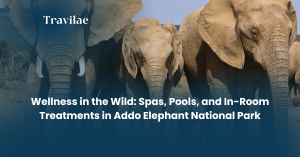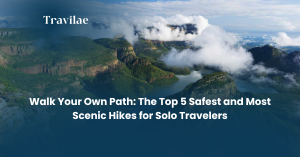
Few places in South Africa offer the raw, rugged solitude of Augrabies Falls National Park. The park’s iconic waterfall and ancient granite landscapes are best explored on foot—especially for solo travelers craving adventure and introspection. This guide dives into solo hiking at Augrabies, focusing on the two most celebrated trails: the Dassie Interpretive Trail and the legendary Klipspringer Trail. Discover what to expect, how to prepare, and why these hikes are a must for independent explorers.
Table of Contents
The Dassie Interpretive Trail: Solo-Friendly and Scenic
Trail Overview
- Distance: 5–8 km circular route (trail length may vary slightly by source)
- Start/End: Rest Camp
- Route: Follows the gorge to Arrow Point, past Twin Falls and Moon Rock, looping back to camp
- Difficulty: Moderate, with some scrambling over rocks
- Duration: 2–3 hours at a relaxed pace
Why It’s Great for Solo Hikers
- Self-Guided: No minimum group size; hike at your own pace
- Well-Marked: Maps available at reception; clear signage along the route
- Varied Scenery: Traverse dramatic gorges, panoramic viewpoints, and the famous Moon Rock
- Wildlife Encounters: Look out for rock dassies, lizards, and klipspringers
Tips for Solo Hikers
- Start early to beat the heat, especially in summer
- Carry plenty of water, sunscreen, and a hat
- Wear sturdy shoes for rocky terrain and occasional scrambling
- Take your time at viewpoints—sunrise and sunset are especially beautiful
The Klipspringer Trail: A Multi-Day Wilderness Adventure
Trail Overview
- Distance: 35.8–39 km (3 days, 2 nights)
- Route: Circular, starting and ending near the Rest Camp; traverses gorges, riverbanks, and granite domes
- Difficulty: Challenging; rated “difficult” due to terrain and climate
- Season: Open April–September (closed October–March due to extreme heat)
- Group Requirement: Minimum 2, maximum 12 hikers per group (solo hikers must join a group)
Trail Breakdown
| Day | Distance | Terrain & Highlights | Estimated Time |
|---|---|---|---|
| 1 | 14.4 km | Gorge views, waterfalls, rocky outcrops | ~7 hours |
| 2 | 9.9–13 km | Sandy riverbanks, indigenous flora, tough going | ~6 hours |
| 3 | 11.5–12.5km | Quiver trees, easier terrain, panoramic views | ~6 hours |
- Overnight Huts: Rustic stone huts with bunks, mattresses, toilets, water for washing, firewood, and basic cookware. No electricity or showers.
- Self-sufficiency: Bring all food, sleeping bags, crockery, cutlery, and a water purification device (drinking water not provided on trail).
Why It’s a Bucket-List Hike
- Immersive Wilderness: Traverse remote, starkly beautiful landscapes far from crowds
- Wildlife: Spot klipspringers, baboons, monkeys, steenbok, and a variety of birds
- Stargazing: Nights in the huts offer some of the clearest skies in South Africa
- Physical Challenge: Rugged terrain and weather test your endurance and spirit
Tips for Solo Hikers
- Booking: Solo hikers must join a group—book in advance and connect with other hikers via forums or the park office
- Fitness: Prepare for strenuous days carrying a loaded backpack
- Safety: Carry a map, compass, first aid kit, and a fully charged phone (signal is patchy)
- Hydration: Bring a water filter or purification tablets; trail water is not safe to drink untreated
- Start Early: Beat the midday heat and give yourself plenty of daylight
Essential Safety and Preparation
- Weather: Even in winter, days can be hot and nights cold—pack layers
- Navigation: Trails are marked but keep an eye out for cairns and markers
- Wildlife: Respect animals and keep a safe distance; do not feed wildlife
- Emergencies: Rangers provide an emergency contact number; inform them of your plans before heading out
- Leave No Trace: Carry out all trash and do not collect firewood (supplied at huts)
Real-World Insight: A Solo Hiker’s Reflection
On the Dassie Trail, I found myself alone atop Moon Rock as the sun dipped below the horizon, the granite glowing orange and the only sound the distant thunder of the falls. The solitude was profound—equal parts exhilarating and humbling. On the Klipspringer Trail, camaraderie with fellow hikers formed quickly, but moments of quiet reflection along the riverbank made the journey unforgettable. Augrabies is a place where solo hikers can truly reconnect with nature and themselves.
Quick Comparison: Dassie vs Klipspringer Trails
| Feature | Dassie Trail | Klipspringer Trail |
|---|---|---|
| Distance | 5–8 km (1 day) | 35.8–39 km (3 days) |
| Difficulty | Moderate | Difficult |
| Solo Hiking | Yes, self-guided | No, must join group |
| Scenery | Gorge, Moon Rock, viewpoints | Gorges, river, domes, flora |
| Wildlife | Dassies, lizards, birds | Klipspringers, baboons, birds |
| Accommodation | Rest Camp | Rustic huts (no electricity) |
| Booking | Walk-in | Advance booking required |
Conclusion
Solo hiking at Augrabies Falls National Park is a rewarding, soul-stirring experience. The Dassie Trail is perfect for independent exploration, offering dramatic scenery and wildlife in a manageable day hike. The Klipspringer Trail, while requiring you to join a group, delivers a true wilderness adventure and the chance to push your limits. Whichever you choose, Augrabies promises solitude, beauty, and the thrill of discovery.
Are you ready to tackle the trails of Augrabies Falls on your own terms? Share your hiking dreams or experiences in the comments!






